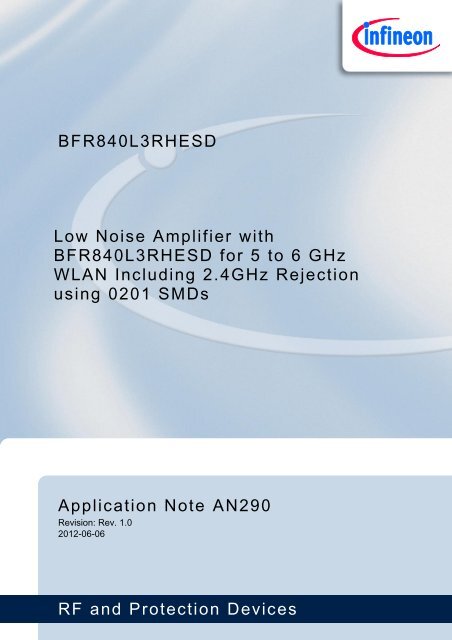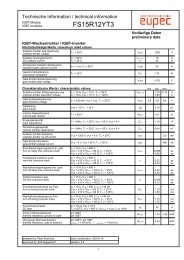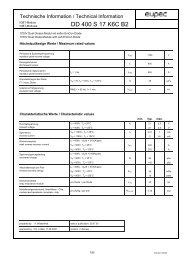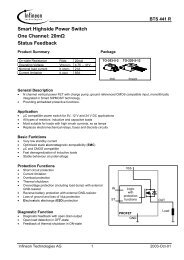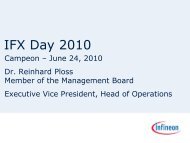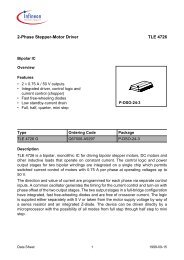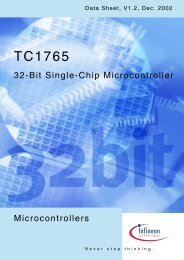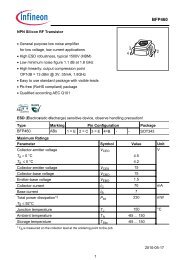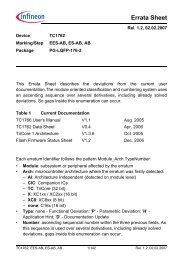AN290 - Low Noise Amplifier with BFR840L3RHESD for 5 - Infineon
AN290 - Low Noise Amplifier with BFR840L3RHESD for 5 - Infineon
AN290 - Low Noise Amplifier with BFR840L3RHESD for 5 - Infineon
Create successful ePaper yourself
Turn your PDF publications into a flip-book with our unique Google optimized e-Paper software.
<strong>BFR840L3RHESD</strong><br />
<strong>Low</strong> <strong>Noise</strong> <strong>Amplifier</strong> <strong>with</strong><br />
<strong>BFR840L3RHESD</strong> <strong>for</strong> 5 to 6 GHz<br />
WLAN Including 2.4GHz Rejection<br />
using 0201 SMDs<br />
Application Note <strong>AN290</strong><br />
Revision: Rev. 1.0<br />
2012-06-06<br />
RF and Protection Devices
Edition 2012-06-06<br />
Published by<br />
<strong>Infineon</strong> Technologies AG<br />
81726 Munich, Germany<br />
© 2012 <strong>Infineon</strong> Technologies AG<br />
All Rights Reserved.<br />
Legal Disclaimer<br />
The in<strong>for</strong>mation given in this document shall in no event be regarded as a guarantee of conditions or<br />
characteristics. With respect to any examples or hints given herein, any typical values stated herein and/or any<br />
in<strong>for</strong>mation regarding the application of the device, <strong>Infineon</strong> Technologies hereby disclaims any and all<br />
warranties and liabilities of any kind, including <strong>with</strong>out limitation, warranties of non-infringement of intellectual<br />
property rights of any third party.<br />
In<strong>for</strong>mation<br />
For further in<strong>for</strong>mation on technology, delivery terms and conditions and prices, please contact the nearest<br />
<strong>Infineon</strong> Technologies Office (www.infineon.com).<br />
Warnings<br />
Due to technical requirements, components may contain dangerous substances. For in<strong>for</strong>mation on the types in<br />
question, please contact the nearest <strong>Infineon</strong> Technologies Office.<br />
<strong>Infineon</strong> Technologies components may be used in life-support devices or systems only <strong>with</strong> the express written<br />
approval of <strong>Infineon</strong> Technologies, if a failure of such components can reasonably be expected to cause the<br />
failure of that life-support device or system or to affect the safety or effectiveness of that device or system. Life<br />
support devices or systems are intended to be implanted in the human body or to support and/or maintain and<br />
sustain and/or protect human life. If they fail, it is reasonable to assume that the health of the user or other<br />
persons may be endangered.
Application Note <strong>AN290</strong><br />
Revision History: 2012-06-06<br />
Previous Revision: No previous revision<br />
<strong>BFR840L3RHESD</strong><br />
<strong>Low</strong> <strong>Noise</strong> <strong>Amplifier</strong> <strong>for</strong> 5 to 6 GHz WLAN <strong>with</strong> 2.4 GHz Rejection<br />
Page Subjects (major changes since last revision)<br />
Trademarks of <strong>Infineon</strong> Technologies AG<br />
AURIX, C166, CanPAK, CIPOS, CIPURSE, EconoPACK, CoolMOS, CoolSET,<br />
CORECONTROL, CROSSAVE, DAVE, DI-POL, EasyPIM, EconoBRIDGE, EconoDUAL,<br />
EconoPIM, EconoPACK, EiceDRIVER, eupec, FCOS, HITFET, HybridPACK, I²RF,<br />
ISOFACE, IsoPACK, MIPAQ, ModSTACK, my-d, NovalithIC, OptiMOS, ORIGA,<br />
POWERCODE, PRIMARION, PrimePACK, PrimeSTACK, PRO-SIL, PROFET, RASIC,<br />
ReverSave, SatRIC, SIEGET, SINDRION, SIPMOS, SmartLEWIS, SOLID FLASH,<br />
TEMPFET, thinQ!, TRENCHSTOP, TriCore.<br />
Other Trademarks<br />
Advance Design System (ADS) of Agilent Technologies, AMBA, ARM, MULTI-ICE, KEIL,<br />
PRIMECELL, REALVIEW, THUMB, µVision of ARM Limited, UK. AUTOSAR is licensed by<br />
AUTOSAR development partnership. Bluetooth of Bluetooth SIG Inc. CAT-iq of DECT Forum.<br />
COLOSSUS, FirstGPS of Trimble Navigation Ltd. EMV of EMVCo, LLC (Visa Holdings Inc.). EPCOS<br />
of Epcos AG. FLEXGO of Microsoft Corporation. FlexRay is licensed by FlexRay Consortium.<br />
HYPERTERMINAL of Hilgraeve Incorporated. IEC of Commission Electrotechnique Internationale. IrDA<br />
of Infrared Data Association Corporation. ISO of INTERNATIONAL ORGANIZATION FOR<br />
STANDARDIZATION. MATLAB of MathWorks, Inc. MAXIM of Maxim Integrated Products, Inc.<br />
MICROTEC, NUCLEUS of Mentor Graphics Corporation. MIPI of MIPI Alliance, Inc. MIPS of MIPS<br />
Technologies, Inc., USA. muRata of MURATA MANUFACTURING CO., MICROWAVE OFFICE (MWO) of<br />
Applied Wave Research Inc., OmniVision of OmniVision Technologies, Inc. Openwave Openwave Systems<br />
Inc. RED HAT Red Hat, Inc. RFMD RF Micro Devices, Inc. SIRIUS of Sirius Satellite Radio Inc.<br />
SOLARIS of Sun Microsystems, Inc. SPANSION of Spansion LLC Ltd. Symbian of Symbian Software<br />
Limited. TAIYO YUDEN of Taiyo Yuden Co. TEAKLITE of CEVA, Inc. TEKTRONIX of Tektronix Inc.<br />
TOKO of TOKO KABUSHIKI KAISHA TA. UNIX of X/Open Company Limited. VERILOG, PALLADIUM<br />
of Cadence Design Systems, Inc. VLYNQ of Texas Instruments Incorporated. VXWORKS, WIND RIVER<br />
of WIND RIVER SYSTEMS, INC. ZETEX of Diodes Zetex Limited.<br />
Last Trademarks Update 2011-11-11<br />
Application Note <strong>AN290</strong>, Rev. 1.0 3 / 21<br />
2012-06-06
Table of Content<br />
<strong>BFR840L3RHESD</strong><br />
<strong>Low</strong> <strong>Noise</strong> <strong>Amplifier</strong> <strong>for</strong> 5 to 6 GHz WLAN <strong>with</strong> 2.4 GHz Rejection<br />
List of Content, Figures and Tables<br />
1 Introduction ........................................................................................................................................ 5<br />
1.1 Wi-Fi ® ................................................................................................................................................... 5<br />
1.2 Device Overview: <strong>BFR840L3RHESD</strong> .................................................................................................. 6<br />
2 5 to 6 GHz WLAN LNA <strong>with</strong> 2.4 GHz Rejection using <strong>BFR840L3RHESD</strong> ...................................... 7<br />
3 Overview ............................................................................................................................................. 8<br />
4 Summary of Measurement Results .................................................................................................. 8<br />
5 Schematics ......................................................................................................................................... 9<br />
6 Measured Graphs ............................................................................................................................. 11<br />
7 Evaluation Board and Layout In<strong>for</strong>mation .................................................................................... 18<br />
8 Authors .............................................................................................................................................. 20<br />
9 Remark .............................................................................................................................................. 20<br />
List of Figures<br />
Figure 1 5 – 6 GHz Wi-Fi ® Wireless LAN (WLAN, IEEE802.11a/n/ac) and WiMAX (IEEE802.16e) Front-End 5<br />
Figure 2 Schematic Diagram of the used Circuit ................................................................................................ 9<br />
Figure 3 Insertion Power Gain of the 5-6 GHz WLAN LNA <strong>with</strong> <strong>BFR840L3RHESD</strong> ....................................... 11<br />
Figure 4 Wideband Insertion Power Gain of the 5-6 GHz WLAN LNA <strong>with</strong> <strong>BFR840L3RHESD</strong> ...................... 11<br />
Figure 5 <strong>Noise</strong> Figure of <strong>BFR840L3RHESD</strong> LNA <strong>for</strong> 5100 - 5900 MHz .......................................................... 12<br />
Figure 6 Reverse Isolation of the 5-6 GHz WLAN LNA <strong>with</strong> <strong>BFR840L3RHESD</strong> ............................................. 12<br />
Figure 7 Input Matching of the 5-6 GHz WLAN LNA <strong>with</strong> <strong>BFR840L3RHESD</strong> ................................................. 13<br />
Figure 8 Input Matching of the 5-6 GHz WLAN LNA <strong>with</strong> <strong>BFR840L3RHESD</strong> (Smith Chart) ........................... 13<br />
Figure 9 Output Matching of the 5-6 GHz WLAN LNA <strong>with</strong> <strong>BFR840L3RHESD</strong> .............................................. 14<br />
Figure 10 Output Matching of the 5-6 GHz WLAN LNA <strong>with</strong> <strong>BFR840L3RHESD</strong> (Smith Chart) ........................ 14<br />
Figure 11 Wideband Stability k Factor of the 5-6 GHz WLAN LNA <strong>with</strong> <strong>BFR840L3RHESD</strong> ............................. 15<br />
Figure 12 Wideband Stability Mu Factor of the 5-6 GHz WLAN LNA <strong>with</strong> <strong>BFR840L3RHESD</strong> .......................... 15<br />
Figure 13 Input 1dB Compression Point of the <strong>BFR840L3RHESD</strong> Circuit at 5500 MHz .................................. 16<br />
Figure 14 Output 3 rd Order Intercept Point of <strong>BFR840L3RHESD</strong> at 5500 MHz ................................................ 16<br />
Figure 15 OFF-Mode (Vcc = 0V, Icc = 0mA) S21 of the 5-6 GHz WLAN LNA <strong>with</strong> <strong>BFR840L3RHESD</strong> ............ 17<br />
Figure 16 Input 1dB Compression Point of the <strong>BFR840L3RHESD</strong> Circuit at 2500 MH .................................... 17<br />
Figure 17 Photo of the <strong>BFR840L3RHESD</strong> 5-6 GHz WLAN LNA Evaluation Board .......................................... 18<br />
Figure 18 Zoom-In on the <strong>BFR840L3RHESD</strong> 5-6 GHz WLAN LNA Evaluation Board ..................................... 18<br />
Figure 19 Layout Proposal <strong>for</strong> RF Grounding of the 5-6 GHz WLAN LNA <strong>with</strong> <strong>BFR840L3RHESD</strong> .................. 19<br />
Figure 20 PCB Layer In<strong>for</strong>mation ....................................................................................................................... 19<br />
List of Tables<br />
Table 1 Summary of Measurement Results ...................................................................................................... 8<br />
Table 2 Bill-of-Materials ................................................................................................................................... 10<br />
Application Note <strong>AN290</strong>, Rev. 1.0 4 / 21<br />
2012-06-06
1 Introduction<br />
1.1 Wi-Fi ®<br />
<strong>BFR840L3RHESD</strong><br />
<strong>Low</strong> <strong>Noise</strong> <strong>Amplifier</strong> <strong>for</strong> 5 to 6 GHz WLAN <strong>with</strong> 2.4 GHz Rejection<br />
Introduction<br />
Wireless Fidelity (Wi-Fi ® ) plays a major role in today’s communications by enabling constant<br />
connection in the 2.4 GHz and 5 GHz bands and broadband Internet access <strong>for</strong> users <strong>with</strong><br />
laptops or devices equipped <strong>with</strong> wireless network interface while roaming <strong>with</strong>in the range of<br />
fixed access points (AP) or a public hotspot. Different applications like home entertainment<br />
<strong>with</strong> wireless high-quality multimedia signal transmission, home networking notebooks, mass<br />
data storages and printers implement 5 – 6 GHz Wi-Fi ® into their system to offer high-speed<br />
wireless connectivity.<br />
When wider coverage areas are needed and especially when a higher order modulation<br />
scheme is used such as in emerging very high throughput wireless specifications like 256<br />
Quadrature Amplitude Modulation (256QAM) in IEEE 802.11ac, the SNR requirements <strong>for</strong><br />
both the AP and the client are more stringent. For this kind of high-speed high data rate<br />
wireless communication standards it is essential to ensure the quality of the link path. Major<br />
per<strong>for</strong>mance criteria of these equipments have to be fulfilled: sensitivity, strong signal<br />
capability and interference immunity. Below a general application diagram of a WLAN system<br />
is shown.<br />
WLAN/WiMAX:<br />
4.9 – 5.9 GHz<br />
ESD<br />
Diode<br />
BPF<br />
SPDT<br />
Switch<br />
Figure 1 5 – 6 GHz Wi-Fi ® Wireless LAN (WLAN, IEEE802.11a/n/ac) and WiMAX (IEEE802.16e) Front-<br />
End<br />
LNA<br />
Power Detector<br />
BPF PA<br />
WLAN/<br />
WiMAX<br />
Transceiver IC<br />
Application Note <strong>AN290</strong>, Rev. 1.0 5 / 21<br />
2012-06-06
<strong>BFR840L3RHESD</strong><br />
<strong>Low</strong> <strong>Noise</strong> <strong>Amplifier</strong> <strong>for</strong> 5 to 6 GHz WLAN <strong>with</strong> 2.4 GHz Rejection<br />
Introduction<br />
In order to increase the system sensitivity, an excellent low noise amplifier (LNA) in front of<br />
the receiver is mandatory, especially in an environment <strong>with</strong> very weak signal strength and<br />
because of the insertion loss of the SPDT switch and the Bandpass Filter (BPF) or diplexer.<br />
The typical allowed receiver chain <strong>Noise</strong> Figure (NF) of approx. 2 dB can only be achieved by<br />
using a high-gain low noise amplifier.<br />
In addition, strong signal environment can exist when the equipment is next to a transmitter.<br />
In that case, the LNA must be linear enough, i.e. have high 1dB compression point. This<br />
avoids saturation, degradation of the gain and increased noise figure.<br />
This application note is focusing on the LNA block, but <strong>Infineon</strong> does also support <strong>with</strong> RF-<br />
switches, TVS-diodes <strong>for</strong> ESD protection and RF Schottky diodes <strong>for</strong> power detection.<br />
1.2 Device Overview: <strong>BFR840L3RHESD</strong><br />
The <strong>BFR840L3RHESD</strong> is a discrete hetero-junction bipolar transistor (HBT) specifically<br />
designed <strong>for</strong> high per<strong>for</strong>mance 5 GHz band low noise amplifier (LNA) solutions <strong>for</strong> Wi-Fi<br />
connectivity applications. It combines the 80 GHz fT silicon-germanium:carbide (SiGe:C)<br />
B9HFM process <strong>with</strong> special device geometry engineering to reduce the parasitic<br />
capacitance between substrate and transistor that degrades high-frequency characteristics,<br />
resulting in an inherent input matching and a major improvement in power gain 5 GHz band<br />
together <strong>with</strong> a low noise figure per<strong>for</strong>mance that is industry's best.<br />
The <strong>BFR840L3RHESD</strong> has an integrated 1.5kV HBM ESD protection which makes the<br />
device robust against electrostatic discharge and extreme RF input power. The device offers<br />
its high per<strong>for</strong>mance at low current and voltage and is especially well-suited <strong>for</strong> portable<br />
battery powered applications in which energy efficiency is a key requirement.<br />
The <strong>BFR840L3RHESD</strong> is housed in low-height 0.31mm TSLP-3-9 package specially fitting<br />
into modules. Further variants are available in industry standard visible-leads SOT343<br />
package (BFP840ESD) and in flat-leads TSFP-4-1 package (BFP840FESD).<br />
Application Note <strong>AN290</strong>, Rev. 1.0 6 / 21<br />
2012-06-06
<strong>BFR840L3RHESD</strong><br />
<strong>Low</strong> <strong>Noise</strong> <strong>Amplifier</strong> <strong>for</strong> 5 to 6 GHz WLAN <strong>with</strong> 2.4 GHz Rejection<br />
5 to 6 GHz WLAN LNA <strong>with</strong> 2.4 GHz Rejection using <strong>BFR840L3RHESD</strong><br />
2 5 to 6 GHz WLAN LNA <strong>with</strong> 2.4 GHz Rejection using<br />
<strong>BFR840L3RHESD</strong><br />
This application note presents the measurement results of the <strong>Low</strong> <strong>Noise</strong> <strong>Amplifier</strong> using<br />
<strong>BFR840L3RHESD</strong> <strong>for</strong> 5100 MHz to 5900 MHz WLAN applications. The circuit schematic<br />
shown in Figure 2 doesn’t require any external input matching elements. High rejection at 2.4<br />
GHz band is achieved using a LC notch filter at the input of the LNA.<br />
It requires 10 passive 0201 size SMD components and brings gain from 14.9 dB to 14.4 dB<br />
over the frequency band. The noise figure varies from 1.08 dB to 1.03 dB (SMA and PCB<br />
losses are subtracted) over the complete frequency band. Moreover, 1dB compression point<br />
IP1dB at 2.4 - 2.5 GHz band is more than 0 dBm at input.<br />
The circuit achieves an input and output return loss of 11 dB. Furthermore, the circuit is<br />
unconditionally stable from 10 MHz to 11 GHz.<br />
At 5.5 GHz, using two tones spacing of 1 MHz, the output third intercept point OIP3 reaches<br />
16.3 dBm. Besides, we obtain 1dB input compression point IP1dB of -8.3 dBm.<br />
Application Note <strong>AN290</strong>, Rev. 1.0 7 / 21<br />
2012-06-06
3 Overview<br />
<strong>BFR840L3RHESD</strong><br />
<strong>Low</strong> <strong>Noise</strong> <strong>Amplifier</strong> <strong>for</strong> 5 to 6 GHz WLAN <strong>with</strong> 2.4 GHz Rejection<br />
Overview<br />
Device: <strong>BFR840L3RHESD</strong><br />
Application: <strong>Low</strong> <strong>Noise</strong> <strong>Amplifier</strong> <strong>for</strong> 5 to 6 GHz WLAN <strong>with</strong> 2.4 GHz Rejection<br />
PCB Marking: <strong>BFR840L3RHESD</strong> TSLP-3-9 M120510<br />
4 Summary of Measurement Results<br />
Table 1 Summary of Measurement Results<br />
Parameter Symbol Value Unit Note/Test Condition<br />
DC Voltage Vcc 3.0 V<br />
DC Current Icc 9.2 mA<br />
Frequency Range Freq 2500 5100 5500 5900 MHz<br />
Gain G 1.6 14.9 14.5 14.4 dB<br />
<strong>Noise</strong> Figure NF 1.05 1.03 1.05 dB<br />
Input Return Loss RLin 11.9 11.7 11 dB<br />
Output Return<br />
Loss<br />
RLout 15 18.3 21 dB<br />
Reverse Isolation IRev 22.9 22.4 21.8 dB<br />
Input P1dB IP1dB 0 -8.3 dBm<br />
Output P1dB OP1dB 0.6 +5.2 dBm<br />
Input IP3 IIP3 +1.8 dBm<br />
Output IP3 OIP3 +16.3 dBm<br />
Stability k > 1.0 --<br />
SMA and PCB losses (~0.15<br />
dB) are subtracted<br />
Power @ Input: -25 dBm<br />
f1= 5500 MHz, f2= 5501 MHz<br />
Stability measured from 10MHz<br />
to 11GHz<br />
Application Note <strong>AN290</strong>, Rev. 1.0 8 / 21<br />
2012-06-06
5 Schematics<br />
J1<br />
RF Port1<br />
INPUT<br />
Figure 2 Schematic Diagram of the used Circuit<br />
<strong>BFR840L3RHESD</strong><br />
<strong>Low</strong> <strong>Noise</strong> <strong>Amplifier</strong> <strong>for</strong> 5 to 6 GHz WLAN <strong>with</strong> 2.4 GHz Rejection<br />
Schematics<br />
C1<br />
22pF<br />
C5<br />
2.2pF<br />
L2<br />
1.8nH<br />
Total externals Count = 10<br />
R3<br />
120<br />
ohms<br />
Inductors = 2 (LQP03T Series)<br />
Resistors = 3<br />
Capacitors = 5<br />
V cc = 3.0 V<br />
J3<br />
DC Connector<br />
I = 9.2 mA<br />
R1<br />
33k<br />
Ohms<br />
C4<br />
33pF<br />
R2<br />
27 ohms<br />
Q1<br />
<strong>BFR840L3RHESD</strong><br />
J2<br />
RF Port2<br />
OUTPUT<br />
Application Note <strong>AN290</strong>, Rev. 1.0 9 / 21<br />
2012-06-06<br />
L1<br />
3.8nH<br />
All passives are “0201“ case size<br />
Inductor L1 LQP03T Series<br />
Capacitors GRM Series<br />
C3<br />
0.3pF<br />
C2<br />
18pF<br />
A proper RF grounding is required to ensure<br />
the LNA per<strong>for</strong>mance. Please refer to Chapter<br />
7 <strong>for</strong> the layout proposal.<br />
PCB Marking= <strong>BFR840L3RHESD</strong> TSLP-3-9 M120510<br />
PCB Board Material = Standard FR4<br />
Layer spacing (top RF to internal ground plane): 0.2 mm
Table 2 Bill-of-Materials<br />
<strong>BFR840L3RHESD</strong><br />
<strong>Low</strong> <strong>Noise</strong> <strong>Amplifier</strong> <strong>for</strong> 5 to 6 GHz WLAN <strong>with</strong> 2.4 GHz Rejection<br />
Schematics<br />
Symbol Value Unit Size Manufacturer Comment<br />
C1 22 pF 0201 Various Input DC block<br />
C2 18 pF 0201 Various Output DC block<br />
C3 0.3 pF 0201 Various Output matching. Influence the input<br />
matching as well.<br />
C4 33 pF 0201 Various RF decoupling / blocking cap<br />
C5 2.2 pF 0201 Various 2.4 GHz rejection<br />
L1 3.8 nH 0201 Murata LQP03T series Output matching and biasing to the<br />
Collector<br />
L2 1.8 nH 0201 Murata LQP03T series 2.4 GHz rejection<br />
R1 33 kΩ 0201 Various DC biasing<br />
R2 27 Ω 0201 Various Stability improvement<br />
R3 120 Ω 0201 Various DC biasing (provides DC negative<br />
feedback to stabilize DC operating<br />
point over temperature variation,<br />
transistor hFE variation, etc.)<br />
Q1 TSLP-3-9 <strong>Infineon</strong> Technologies <strong>BFR840L3RHESD</strong> SiGe:C<br />
Heterojunction Bipolar RF Transistor<br />
Application Note <strong>AN290</strong>, Rev. 1.0 10 / 21<br />
2012-06-06
6 Measured Graphs<br />
17<br />
16<br />
15<br />
14<br />
<strong>BFR840L3RHESD</strong><br />
<strong>Low</strong> <strong>Noise</strong> <strong>Amplifier</strong> <strong>for</strong> 5 to 6 GHz WLAN <strong>with</strong> 2.4 GHz Rejection<br />
Measured Graphs<br />
Insertion Power Gain InBand<br />
13<br />
4000 4500 5000 5500<br />
Frequency (MHz)<br />
6000 6500 7000<br />
Figure 3 Insertion Power Gain of the 5-6 GHz WLAN LNA <strong>with</strong> <strong>BFR840L3RHESD</strong><br />
20<br />
15<br />
10<br />
5<br />
0<br />
-5<br />
2500 MHz<br />
1.61 dB<br />
2400 MHz<br />
-9.32 dB<br />
5100 MHz<br />
14.9 dB<br />
5900 MHz<br />
14.4 dB<br />
Insertion Power Gain WideBand<br />
5100 MHz<br />
14.9 dB<br />
5900 MHz<br />
14.4 dB<br />
-10<br />
2000 2500 3000 3500 4000 4500 5000 5500 6000 6500 7000 7500 8000<br />
Frequency (MHz)<br />
Figure 4 Wideband Insertion Power Gain of the 5-6 GHz WLAN LNA <strong>with</strong> <strong>BFR840L3RHESD</strong><br />
Application Note <strong>AN290</strong>, Rev. 1.0 11 / 21<br />
2012-06-06
NF(dB)<br />
1.4<br />
1.3<br />
1.2<br />
1.1<br />
1<br />
0.9<br />
0.8<br />
<strong>BFR840L3RHESD</strong><br />
<strong>Low</strong> <strong>Noise</strong> <strong>Amplifier</strong> <strong>for</strong> 5 to 6 GHz WLAN <strong>with</strong> 2.4 GHz Rejection<br />
Measured Graphs<br />
<strong>Noise</strong> Figure<br />
0.7<br />
5100 5300 5500<br />
Frequency (MHz)<br />
5700 5900<br />
Figure 5 <strong>Noise</strong> Figure of <strong>BFR840L3RHESD</strong> LNA <strong>for</strong> 5100 - 5900 MHz<br />
60<br />
50<br />
40<br />
30<br />
20<br />
10<br />
5100 MHz<br />
1.05 dB<br />
5100 MHz<br />
22.9 dB<br />
5500 MHz<br />
1.03 dB<br />
Reverse Isolation<br />
5900 MHz<br />
21.8 dB<br />
5800 MHz<br />
1.08 dB<br />
Figure 6 Reverse Isolation of the 5-6 GHz WLAN LNA <strong>with</strong> <strong>BFR840L3RHESD</strong><br />
5900 MHz<br />
1.05 dB<br />
0<br />
4000 4500 5000 5500<br />
Frequency (MHz)<br />
6000 6500 7000<br />
Application Note <strong>AN290</strong>, Rev. 1.0 12 / 21<br />
2012-06-06
-8<br />
-9<br />
-10<br />
-11<br />
-12<br />
-13<br />
<strong>BFR840L3RHESD</strong><br />
<strong>Low</strong> <strong>Noise</strong> <strong>Amplifier</strong> <strong>for</strong> 5 to 6 GHz WLAN <strong>with</strong> 2.4 GHz Rejection<br />
Measured Graphs<br />
Input Matching<br />
-14<br />
4000 4500 5000 5500<br />
Frequency (MHz)<br />
6000 6500 7000<br />
Figure 7 Input Matching of the 5-6 GHz WLAN LNA <strong>with</strong> <strong>BFR840L3RHESD</strong><br />
0<br />
0.2<br />
-0.2<br />
0.4<br />
0.2<br />
-0.4<br />
5100 MHz<br />
-11.9 dB<br />
0.6<br />
5900 MHz<br />
r 0.568741<br />
x 0.053913<br />
-0.6<br />
0.4<br />
5900 MHz<br />
-11.1 dB<br />
Input Matching Smith<br />
0.6<br />
0.8<br />
Figure 8 Input Matching of the 5-6 GHz WLAN LNA <strong>with</strong> <strong>BFR840L3RHESD</strong> (Smith Chart)<br />
0.8<br />
5100 MHz<br />
r 0.602395<br />
x -0.086714<br />
-0.8<br />
1.0<br />
-1.0<br />
1.0<br />
Application Note <strong>AN290</strong>, Rev. 1.0 13 / 21<br />
2012-06-06<br />
2.0<br />
3.0<br />
2.0<br />
-2.0<br />
4.0<br />
5.0<br />
-3.0<br />
Swp Max<br />
7000MHz<br />
3.0<br />
10.0<br />
4.0<br />
5.0<br />
10.0<br />
-10.0<br />
-5.0<br />
-4.0<br />
Swp Min<br />
3500MHz
-5<br />
-10<br />
-15<br />
-20<br />
<strong>BFR840L3RHESD</strong><br />
<strong>Low</strong> <strong>Noise</strong> <strong>Amplifier</strong> <strong>for</strong> 5 to 6 GHz WLAN <strong>with</strong> 2.4 GHz Rejection<br />
Measured Graphs<br />
Output Matching<br />
-25<br />
4000 4500 5000 5500<br />
Frequency (MHz)<br />
6000 6500 7000<br />
Figure 9 Output Matching of the 5-6 GHz WLAN LNA <strong>with</strong> <strong>BFR840L3RHESD</strong><br />
0<br />
0.2<br />
-0.2<br />
0.4<br />
0.2<br />
-0.4<br />
0.6<br />
-0.6<br />
5100 MHz<br />
-15 dB<br />
Output Matching Smith<br />
5900 MHz<br />
r 0.86982<br />
x -0.106505<br />
0.4<br />
5100 MHz<br />
r 0.765246<br />
x -0.211879<br />
0.6<br />
0.8<br />
-0.8<br />
5900 MHz<br />
-21 dB<br />
Figure 10 Output Matching of the 5-6 GHz WLAN LNA <strong>with</strong> <strong>BFR840L3RHESD</strong> (Smith Chart)<br />
0.8<br />
1.0<br />
-1.0<br />
1.0<br />
Application Note <strong>AN290</strong>, Rev. 1.0 14 / 21<br />
2012-06-06<br />
2.0<br />
3.0<br />
2.0<br />
-2.0<br />
4.0<br />
5.0<br />
-3.0<br />
Swp Max<br />
7000MHz<br />
3.0<br />
10.0<br />
4.0<br />
5.0<br />
10.0<br />
-10.0<br />
-5.0<br />
-4.0<br />
Swp Min<br />
3500MHz
3<br />
2<br />
1<br />
0<br />
<strong>BFR840L3RHESD</strong><br />
<strong>Low</strong> <strong>Noise</strong> <strong>Amplifier</strong> <strong>for</strong> 5 to 6 GHz WLAN <strong>with</strong> 2.4 GHz Rejection<br />
Measured Graphs<br />
Stability k Factor<br />
10 2010 4010 6010 8010 10000<br />
Frequency (MHz)<br />
Figure 11 Wideband Stability k Factor of the 5-6 GHz WLAN LNA <strong>with</strong> <strong>BFR840L3RHESD</strong><br />
2<br />
1.5<br />
1<br />
0.5<br />
0<br />
Stability Mu Factor<br />
Mu2 factor<br />
Mu1 factor<br />
10 2010 4010 6010 8010 10000<br />
Frequency (MHz)<br />
Figure 12 Wideband Stability Mu Factor of the 5-6 GHz WLAN LNA <strong>with</strong> <strong>BFR840L3RHESD</strong><br />
Application Note <strong>AN290</strong>, Rev. 1.0 15 / 21<br />
2012-06-06
<strong>BFR840L3RHESD</strong><br />
<strong>Low</strong> <strong>Noise</strong> <strong>Amplifier</strong> <strong>for</strong> 5 to 6 GHz WLAN <strong>with</strong> 2.4 GHz Rejection<br />
Measured Graphs<br />
Figure 13 Input 1dB Compression Point of the <strong>BFR840L3RHESD</strong> Circuit at 5500 MHz<br />
Power (dBm)<br />
Gain(dB)<br />
20<br />
15<br />
10<br />
5<br />
0<br />
-30 dBm<br />
14.52 dB<br />
Input 1dB Compression Point at 5500 MHz<br />
-8.32 dBm<br />
13.52 dB<br />
-30 -25 -20 -15 -10 -5 0<br />
Pin (dBm)<br />
0<br />
-20<br />
-40<br />
-60<br />
-80<br />
Output 3rd Order Intercept Point<br />
5500 MHz<br />
-10.5<br />
-100<br />
5498.5 5499.5 5500.5<br />
Frequency (MHz)<br />
5501.5 5502.5<br />
Figure 14 Output 3 rd Order Intercept Point of <strong>BFR840L3RHESD</strong> at 5500 MHz<br />
5502 MHz<br />
-64.2<br />
Application Note <strong>AN290</strong>, Rev. 1.0 16 / 21<br />
2012-06-06
<strong>BFR840L3RHESD</strong><br />
<strong>Low</strong> <strong>Noise</strong> <strong>Amplifier</strong> <strong>for</strong> 5 to 6 GHz WLAN <strong>with</strong> 2.4 GHz Rejection<br />
Measured Graphs<br />
Figure 15 OFF-Mode (Vcc = 0V, Icc = 0mA) S21 of the 5-6 GHz WLAN LNA <strong>with</strong> <strong>BFR840L3RHESD</strong><br />
Gain(dB)<br />
-16<br />
-18<br />
-20<br />
-22<br />
-24<br />
OFF Mode S21<br />
-26<br />
4000 4500 5000 5500<br />
Frequency (MHz)<br />
6000 6500 7000<br />
5<br />
3<br />
1<br />
-1<br />
-3<br />
-5<br />
-25.00 dBm<br />
1.61 dB<br />
5100 MHz<br />
-19.5 dB<br />
5900 MHz<br />
-21.3 dB<br />
Input 1dB Compression Point at 2500 MHz<br />
-0.03 dBm<br />
0.6 dB<br />
-25 -20 -15 -10 -5 0 5<br />
Pin (dBm)<br />
Figure 16 Input 1dB Compression Point of the <strong>BFR840L3RHESD</strong> Circuit at 2500 MH<br />
Application Note <strong>AN290</strong>, Rev. 1.0 17 / 21<br />
2012-06-06
<strong>BFR840L3RHESD</strong><br />
<strong>Low</strong> <strong>Noise</strong> <strong>Amplifier</strong> <strong>for</strong> 5 to 6 GHz WLAN <strong>with</strong> 2.4 GHz Rejection<br />
Evaluation Board and Layout In<strong>for</strong>mation<br />
7 Evaluation Board and Layout In<strong>for</strong>mation<br />
Figure 17 Photo of the <strong>BFR840L3RHESD</strong> 5-6 GHz WLAN LNA Evaluation Board<br />
Figure 18 Zoom-In on the <strong>BFR840L3RHESD</strong> 5-6 GHz WLAN LNA Evaluation Board<br />
Application Note <strong>AN290</strong>, Rev. 1.0 18 / 21<br />
2012-06-06
<strong>BFR840L3RHESD</strong><br />
<strong>Low</strong> <strong>Noise</strong> <strong>Amplifier</strong> <strong>for</strong> 5 to 6 GHz WLAN <strong>with</strong> 2.4 GHz Rejection<br />
Evaluation Board and Layout In<strong>for</strong>mation<br />
Figure 19 Layout Proposal <strong>for</strong> RF Grounding of the 5-6 GHz WLAN LNA <strong>with</strong> <strong>BFR840L3RHESD</strong><br />
Copper<br />
35µm<br />
Figure 20 PCB Layer In<strong>for</strong>mation<br />
FR4 Core, 0.2mm<br />
FR4 Prepreg,<br />
0.8mm<br />
Application Note <strong>AN290</strong>, Rev. 1.0 19 / 21<br />
2012-06-06<br />
Vias
8 Authors<br />
<strong>BFR840L3RHESD</strong><br />
<strong>Low</strong> <strong>Noise</strong> <strong>Amplifier</strong> <strong>for</strong> 5 to 6 GHz WLAN <strong>with</strong> 2.4 GHz Rejection<br />
Authors<br />
Shamsuddin Ahmed, Application Engineer of Business Unit “RF and Protection Devices”<br />
Dr. Chih-I Lin, Senior Staff Engineer/Technical Marketing RF of Business Unit “RF and<br />
Protection Devices”<br />
9 Remark<br />
The graphs are generated <strong>with</strong> the simulation program AWR Microwave Office®.<br />
Application Note <strong>AN290</strong>, Rev. 1.0 20 / 21<br />
2012-06-06
w w w . i n f i n e o n . c o m<br />
Published by <strong>Infineon</strong> Technologies AG <strong>AN290</strong>


